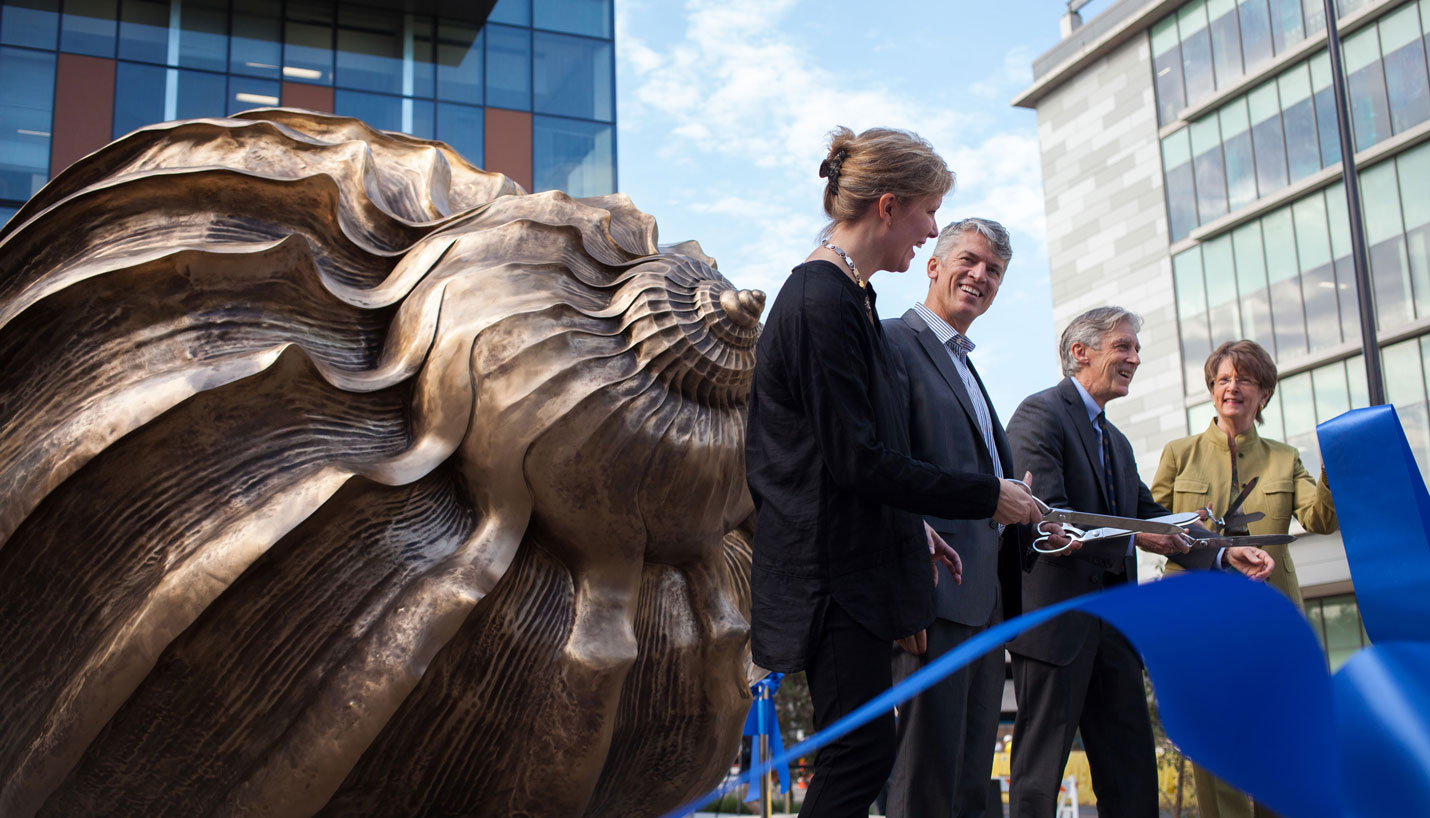


Spiral of the Galaxy at Dell Medical School
On Monday, October 24, Landmarks, the public art program of The University of Texas at Austin, hosted a public ceremony in which Spiral of the Galaxy, a tremendous seven-ton bronze sculpture by British artist Marc Quinn, was unveiled. The public gathering was led by Landmarks director Andrée Bober and included remarks by Clay Johnston, dean of Dell Medical School, Doug Dempster, dean of College of Fine Arts, and Pat Clubb, vice president for University Operations. They spoke in front of the elegant conch shell which stands nearly 11 feet tall and more than 16 feet wide on the northeast corner of 15th and Red River Streets. Senior Principal Larry Speck represented Page at the event.
“Every installation Landmarks does is an educational provocation,” said Dean Doug Dempster. “[Marc Quinn] is an artist who is intrigued by the relationship between the beautiful, the grotesque and the mundane. He’s always looking at the relationship between art and science.”
Located next to the new Page-designed Dell Medical School’s Health Learning Building, and at the heart of the burgeoning health district in downtown Austin, Marc Quinn’s sculpture is emblematic of the human form and healing. The seven-ton bronze depicts an elegant conch shell with chambers that gradually expand in an outward direction. The conch carries cultural and religious significance, and among many interpretations can be seen here as a complex structure that protects delicate organisms.
Modeled after a specimen in the British Natural History Museum, the shell was cast as Quinn’s proof alongside an edition of three and it is the only example of the sculpture in the United States. It was first shown at an exhibition of the artist’s work in 2013 at the Giorgio Cini Foundation in Venice, Italy.
The capital improvement project for the Dell Medical School provided funding to acquire the sculpture. The University of Texas at Austin’s Art in Public Spaces policy sets aside one to two percent of new construction and major renovation funds to acquire public art. Landmarks, one of the most important public art programs to emerge at an American university, added the work to its growing collection of public art presented throughout Austin’s 433-acre main campus. Other artists represented include Michael Ray Charles, Mark di Suvero, David Ellis, Sol LeWitt, Ben Rubin, Nancy Rubins and James Turrell. The collection is broadly accessible and free to all, providing opportunities for students and visitors to engage with great works of art.
Marc Quinn has used his art to investigate the intersection of art and science through a variety of different mediums since catapulting into prominence in the early 1990s. Throughout his career, Quinn has also explored the idea of the human body in relation to perceptions of beauty through such critically acclaimed projects as Self (1991), a cast of the artist’s head made from ten pints of his own frozen blood, and Alison Lapper Pregnant (2005), a marble sculpture depicting disabled artist Alison Lapper, among others. Using both traditional and non-traditional materials, Quinn’s work focuses on the materiality of the object; touching such issues as genetics and the manipulation of DNA, as well as those of life, death and identity.
Born in London in 1964, Quinn studied history and the history of art at Cambridge University. Following his graduation, Quinn worked as an assistant to the sculptor Barry Flanagan. He has exhibited internationally in museums and galleries including Tate Gallery, London (1995), Kunstverein Hannover (1999), Fondazione Prada, Milan (2000), Tate Liverpool (2002), MACRO, Rome (2006), Fondation Beyeler, Basel (2009), White Cube, London (2010), Musée Océanographique, Monaco (2012), and Arter, Space for Art, Istanbul (2014). A major exhibition by Quinn took place at White Cube, London in the summer of 2015.
Established in 2008, Landmarks is the award-winning public art program of The University of Texas at Austin. Founding director Andrée Bober leads the development of the collection and oversees a vibrant range of programs that support scholarship and learning. Landmarks places outdoor public art according to the university’s Public Art Master Plan, developed in collaboration with Peter Walker Partners Landscape Architects. Its collection of modern and contemporary works includes 28 sculptures on long-term loan from the Metropolitan Museum of Art, enabling Landmarks to foster learning through its conservation efforts. Landmarks provides technical training for student volunteers who preserve the sculptures, the only known program of its kind in the United States.
By bringing great art to The University of Texas at Austin, Landmarks enriches the lives of students and visitors, engaging thousands of people every day. For more information, visit www.landmarks.utexas.edu.
Text and images courtesy Landmarks.
10/25/2016
Related Posts
- AAMC 2017 Conference: Learn Serve Lead
- Dell Medical School Specialty Clinics Open
- Creative Thinking in Complex Environments: Conversations in the Garden
- Page Presents at SXSWedu Learn By Design
- Page Sponsors Event Honoring Dell Medical School Leaders
- O N E E V E R Y O N E at Dell Medical School
- 3/3: Multifamily Housing Trends in Fastest-Growing US City








